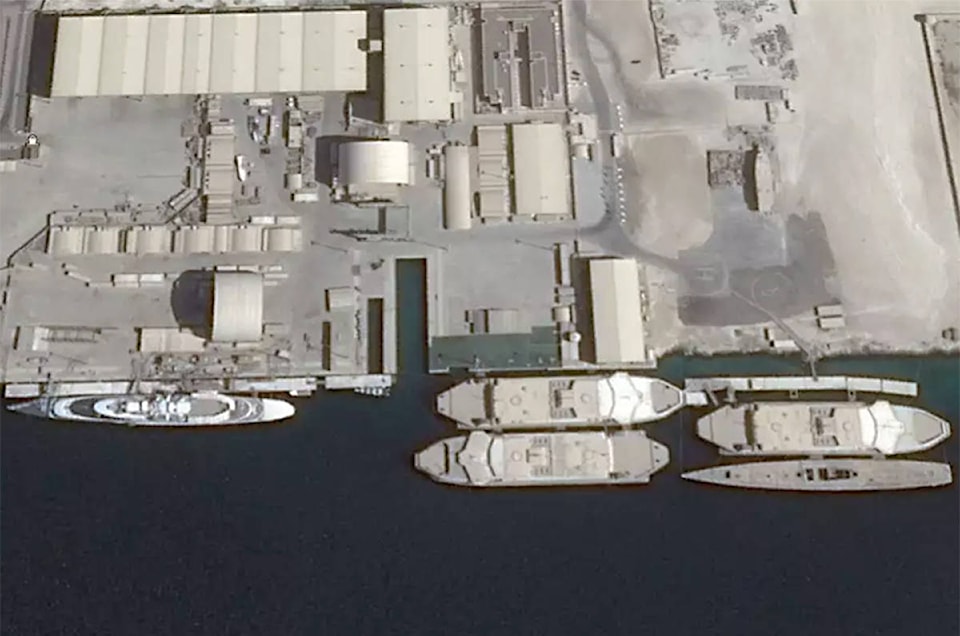Two of the “fast cat” vessels that nearly bankrupted BC Ferries and led to the downfall of the provincial government that approved them ended up sitting idle in a Egyptian harbour.
The catamarans were spotted tied up at the port of Alexandria earlier this year.
In a July 22 post to the ferriesbc.proboards.com message board, “highlander” said he saw the pair tied up on a “long jetty beside some naval ships,” and it looked like they had been sitting idle for some time.
“They look very neglected and COLD STACKED (mothballed) as we say in the oil industry,” the posting said.
“They just look like two big white elephants covered in dust now.”
Attempts at contacting the port, which was described as a combined military and commercial operation, were not successful.
There had been reports that the catamarans Pacificat Discovery, Pacificat Explorer and the Pacificat Voyager were going to be used to ferry workers and supplies to oil rigs off the Egyptian coast.
However, “highlander,” who works in the oil and gas industry, doubted the ships could remain “on station,” holding position in order to load and offload crews and supplies.
Provincial cabinet documents detailing discussions about the fast cats were released under the Freedom of Information and Protection of Privacy Act (FOIPPA) to an unnamed “researcher” and posted on the B.C. government website.
They show that just before the provincial government decided to dock the ferries and put them up for sale, there was a tentative deal to build two more, smaller catamarans for sale to an American corporation to run between Jamestown, New York and Toronto on the Great Lakes.
That would have required more government subsidies, however, and by then, the project was so deeply mired in debt due to cost overruns that the provincial government decided to cut its losses.
The documents show provincial cabinet ministers were told the ‘cats’, which were supposed to replace the conventional “C” class ferries on the Horsehoe Bay - Departure Bay run, were expensive and unreliable.
“The fast ferries have not performed according to original expectations,” a confidential briefing note observed.
“ … the fast ferries have approximately double the fuel and maintenance costs compared to the C-class vessels.”
They could not carry heavy commercial and recreational vehicles, and required an “intensive maintenance schedule” said the report, which put the cost at $19 million a year more than the C-class ferries.
Opportunities to sell the aluminum catamarans to other fast ferry operators were limited by the fact the B.C.-built ships had been designated “sheltered waters vessels,” so they couldn’t be used in many locations such as the English Channel and the Irish sea.
It’s estimated the BC Ferry Corporation lost $400 million on the fast ferries.
The controversy over the cost of the failed fast ferry program is considered to be a factor in the defeat of the NDP government of the day and the election of the Liberals, who eventually sold the three ferries in 2003 to the Washington Marine Group for $19.4 million, less than five per cent of what they cost to build.
In 2009, the three vessels were sold to a luxury yacht builder in Abu Dhabi, the capital of the United Arab Emirates in the Persian Gulf.
A Google Earth satellite image showed them tied up on the dock, and a promotional photo of a luxury yacht showed the dust-covered ferries in the background.
The new owners reportedly planned to operate them as a regional ferry service, but that didn’t happen.
In 2014, according to a Wikipedia entry for the fast cats, all three ferries were donated by the U.A.E. to the Egyptian government for use in the oil and gas industry.
READ ALSO: BC Ferries wants five new ships
dan.ferguson@langleytimes.com
Like us on Facebook and follow us on Twitter



